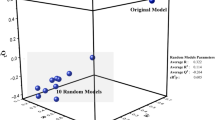Abstract
Optimized calculation of typical acyclic quaternary ammonium compounds (QACs) was performed at B3LYP/6-311G** level using density functional theory (DFT) method. A two- dimensional quantitative structure–activity relationship (2D-QSAR) model was established with the obtained structure parameters as theoretical descriptors. And then three-dimensional quantitative structure–activity relationship (3D-QSAR) models were built using comparative molecular field analysis (CoMFA) and comparative molecular similarity indices analysis (CoMSIA) methods respectively. The 2D and 3D QSAR models exhibit optimum stability and predictive ability, revealing that steric and electronic effects influence the toxicity of acyclic QACs to Scenedesmus Quadricauda mostly.




Similar content being viewed by others
References
Garcia MT, Campos E, Sanchez-Leal J, Ribosa I (1999) Effect of the alkylchainlength on the anaerobic biodegradability and toxicity of quaternary ammonium based surfactants. Chemosphere 38(15):3473–3483
Hu RJ, Barbault F, Delamar M (2009) Receptor- and ligand-based 3D-QSAR study for a series of non-nucleoside HIV-1 reverse transcriptase inhibitors. Bioorg Med Chem 17:2400–2409
Jing GH, Zhou ZM, Zhuo J (2012) Quantitative structure–activity relationship (QSAR) study of toxicity of quaternary ammonium compounds on Chlorella pyrenoidosa and Scenedesmus quadricauda. Chemosphere 86:76–82
Kümmerer K, Eitel A, Braun U, Hubner P, Daschner F, Mascart G, Milandri M, Reinthaler F, Verhoef J (1997) Analysis of benzalkonium chloride in the effluent from European hospitals by solid-phase extraction and high-performance liquid chromatography with post-column ion-pairing and fluorescence detection. J Chromatog. A 774(1–2):281–286
Kuz’min VE, Muratov EN, Artemenko AG, Gorb L, Qasim M, Leszczynski J (2008) The effect of nitroaromatics’ composition on their toxicity in vivo: novel, efficient non-additive 1D QSAR analysis. Chemosphere 72(9):1373–1380
Lessigiarska I, Worth AP, Netzeva TI, Dearden JC, Cronin MTD (2006) Quantitative structure–activity–activity and quantitative structure–activity investigations of human and rodent toxicity. Chemosphere 65(10):1878–1887
Li MH (2012) Survival, mobility, and membrane-bound enzyme activities of freshwater planarian, Dugesia japonica, exposed to synthetic and natural surfactants. Environ Toxicol Chem 31(4):843–850
Li XL, Brownawell BJ (2011) Quaternary ammonium compounds in urban estuarine sediment environments—a class of contaminants in need of increased attention. Environ Sci Technol 44(19):7561–7568
Neu TR (1996) Significance of bacterial surface-active compounds in interaction of bacteria with interfaces. Microbiol Rev 60(1):151–166
Sun XX, Han KN, Choi JK, Kim EK (2004) Screening of surfactants for harmful algal blooms mitigation. Mar Pollut Bull 48(9–10):937–945
Tervo AJ, Nvroenen TH, Rönkkö T, Poso A (2004) Comparing the quality and predictiveness between 3D QSAR models obtained from manual and automated alignment. J Chem Inf Comput Sci 44:807–816
Tezel U, Pierson JA, Pavlostathis SG (2006) Fate and effect of quaternary ammonium compounds on a mixed methanogenic culture. Water Res 40(19):3660–3668
Zhu MJ, Ge F, Zhu RL, Wang XY, Zheng XY (2010) A DFT-based QSAR study of the toxicity of quaternary ammonium compounds on Chlorella vulgaris. Chemosphere 80(1):46–52
Zvinavashe Zvinavashe Elton, Du TT, Griff T, van den Berg HJ, Soffers Ans EMF, Vervoort J, Murk AJ, Ivonne MCM, Rietjens IMCM (2009) Quantitative structure-activity relationship modeling of the toxicity of organothiophosphate pesticides to Daphnia magnaand Cyprinus carpio. Chemosphere 75(11):1531–1538
Author information
Authors and Affiliations
Corresponding author
Rights and permissions
About this article
Cite this article
Qiu, J., Dai, Y., Zhang, X.S. et al. QSAR Modeling of Toxicity of Acyclic Quaternary Ammonium Compounds on Scenedesmus Quadricauda Using 2D and 3D Descriptors. Bull Environ Contam Toxicol 91, 83–88 (2013). https://doi.org/10.1007/s00128-013-1006-7
Received:
Accepted:
Published:
Issue Date:
DOI: https://doi.org/10.1007/s00128-013-1006-7




